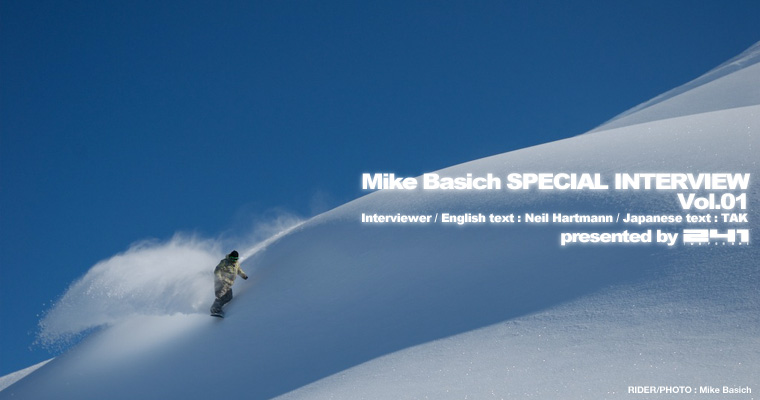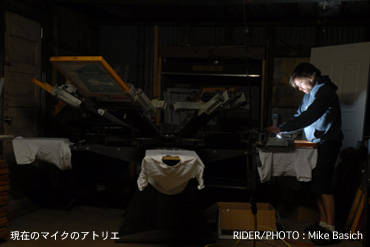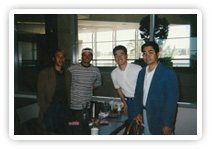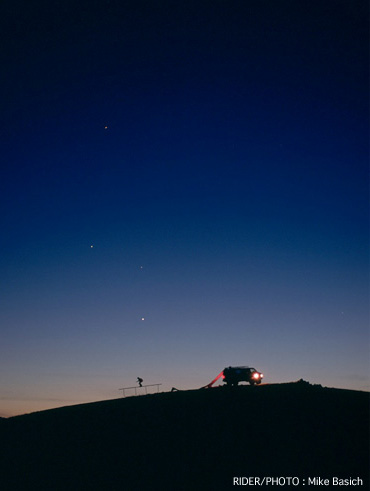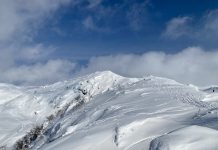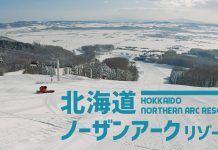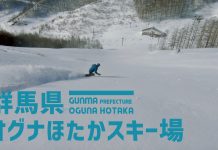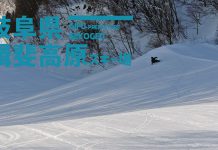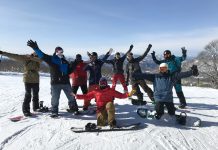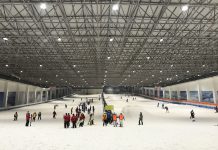2007年9月20日、都内の一室で、スノーボード界のレジェンドの一人でありブランド“241”の創設者でもあるMike Basich(マイク・バシッチ)と話をすることができた。1985年スノーボードに出会って1991年プロになり、以来彼は進化し続けている。マイクは黒いヘアバンドを着けて現れた。着ていた黒いTシャツのデザインは、言葉ではなく色のついた3つの正方形が「黄+青=緑」とプリントされていた。自分で作ったのかと尋ねると彼は、「そうだよ、意味わかる?」と答えた。この人がスノーボードという短い歴史の中で、最高と最悪の時を経験し、彼独自のスタイルで功績を残し続け、語り継いで来た男だ。今現在のマイク・バシッチから何を学び取ることが出来るだろうか。
It is September the 20th 2007 and we are sitting in a small room talking with Mike Basich a legend in Snowboarding and the creator of the brand 241. He discovered Snowboarding in 1985, turned Pro in 1991 and he has never looked back since. Mike comes to the interview with a black headband on to hold back his hair. His T-shirt is black with a self-made silkscreen design that says Yellow + Blue = Green. Not with words just with small blocks of the color. I ask him if he made it himself and he says, “Yeah, do you get the meaning”? This is a man who has been through the both the good and hard times in Snowboarding’s short history, he has survived and continues to leave his mark and tell his story and he has done it all his way! Lets see what we can learn from Mike Basich today!
Interviewer / English text : Neil Hartmann / Japanese text : TAK
![]() 小さい頃から木工用のアトリエをもっていたんだ。大体この部屋の二倍くらいの大きさだったかな。(私達がいた部屋は6畳ほど) 若いときは木工に没頭して、5歳のときにもう最初の作業台を持ってたね。ずっと創り続けてきたよ。
小さい頃から木工用のアトリエをもっていたんだ。大体この部屋の二倍くらいの大きさだったかな。(私達がいた部屋は6畳ほど) 若いときは木工に没頭して、5歳のときにもう最初の作業台を持ってたね。ずっと創り続けてきたよ。
高校最後の二年間で絵をたくさん描くようになってシルクスクリーンを学んで、自分の絵をTシャツにプリントするようになった。スノーボーダーとして服のスポンサーがつき始めたのもその頃かな。
そんなときに自分で他の誰かのものをサイドワークとして作っていこうって思いついたんだ。今までの趣味的な製作も活かせるしね。このアイデアが今まで続いている感じかな。何かが他人のニーズに合っているならそれを提供しようっていうだけで、最初は大きくするつもりはなかったから。今もベルト作ったりシルクスクリーンをしたり自分で創造することに情熱を持っているよ。ウエアを縫ったりする能力はないけど・・・デザインをするのが好きだからね。
その後、ハーフパイプをハイクアップするときにつらい思いをしなくてすむようなウエアを作ることにフォーカスしはじめたんだ。汗だくのコットンじゃ楽しくないじゃん!
スノーボードに出会ってからざっと15年間、やってきたことはコレくらいかな。試合では足が凍りそうに冷たかったり、汗でびしょぬれになったりした思い出がたくさんあるよ。今は技術の進歩でずいぶん変わったけど、僕はこの進歩のプロセスを自分の会社で楽しんでやって来られた。寒いときも過ごしやすいウエアを作ることができたのは幸運にもゴールドウィンと一緒に働けたからだね。
![]()
Growing up I had a little workshop, which was for woodworking. It was maybe twice as big as this room. (the room we are in is about 6 tatami mats) I did a lot of wood working when I was young. I had my first workbench when I was 5. I have always been creating things. The last two years of high school I started drawing a lot and I learned how to silk screen so I started taking my drawings and silk screening on t-shirts and this was at the same time that I was starting to get paid to ride other peoples clothing. So the idea started to come to mind, ok I can promote someone else’s stuff or maybe do this on the side and promote my own back yard thing. And it has kind of stayed like that because that was my first vision, not making it huge, just making something available to people if they want it. I still silk screen, I still have the passion to make the stuff myself. Whether it is sowing belts or silk screening…. I don’t have the ability to sew my own outerwear but…. I like designing it. That was my new focus, lets make something that is not going to be a miserable experience hiking the half pipe because sweating in cotton is not fun! That is basically what I did for the first 15 years of snowboarding. I have a lot of memories of really cold feet and drenched in sweat at contests. That has changed for everybody now with equipment improvements, but I have enjoyed the process on my own with my company. Luckily I have been able to work with Goldwin, which has made it possible to make an outfit that is comfortable in cold weather.
![]() Tシャツのデザインは名無しで始まったんだ。同じ年の夏に、母と姉と一緒になんて名前にするか考ててね、スーパーとかでよく見かける「二枚のピザを一枚分の値段で」って言うフレーズからと、全部数字にしたのは国際的で全ての人に共通だからっていう、2つの理由から241って決まったよ。それから実際に自分のトラックでTシャツ二枚を一枚分の値段で売ったし、次の年にはリバーシブルのパンツを作った。一本買って裏返せば全く別のパンツになるからね。だからそれがブランドのコンセプトだった。
Tシャツのデザインは名無しで始まったんだ。同じ年の夏に、母と姉と一緒になんて名前にするか考ててね、スーパーとかでよく見かける「二枚のピザを一枚分の値段で」って言うフレーズからと、全部数字にしたのは国際的で全ての人に共通だからっていう、2つの理由から241って決まったよ。それから実際に自分のトラックでTシャツ二枚を一枚分の値段で売ったし、次の年にはリバーシブルのパンツを作った。一本買って裏返せば全く別のパンツになるからね。だからそれがブランドのコンセプトだった。
![]()
It started as making artwork on t-shirts with no name and that same summer I think I sat down with my sister and my mother and we were trying to figure out a name. The numbers 241 came up for two reasons. You see those numbers in the supermarket “two pizzas for the price of one”, and because it is just numbers it is very international so everyone can relate to it. I was also selling t-shirts out of the truck of my car two for the price of one, and the next summer I made pants that were reversible. People could buy one pair of pants and turn them inside out and have a totally different pair of pants so that was the concept.
![]() 1991年にプロになったよ。同じ年に241が初めて日本で紹介されたよ。カリフォルニア州のジューンマウンテンでワールドカップ出場権をかけた試合に参加して、上位16名が日本で開催される次の試合の出場権を獲得できるっていう状況で、僕は16位に入った。そうしてスポンサーがNippon Openに僕を送り出してくれたんだ。それが僕とアンディ・ヘーゼルが241の帽子をかぶっていたときだよ。友達のために10個くらいしか作ってなかったのに、帰国して1週間たったら、200個の帽子と100枚のTシャツのオーダーが入っちゃったんだ。
1991年にプロになったよ。同じ年に241が初めて日本で紹介されたよ。カリフォルニア州のジューンマウンテンでワールドカップ出場権をかけた試合に参加して、上位16名が日本で開催される次の試合の出場権を獲得できるっていう状況で、僕は16位に入った。そうしてスポンサーがNippon Openに僕を送り出してくれたんだ。それが僕とアンディ・ヘーゼルが241の帽子をかぶっていたときだよ。友達のために10個くらいしか作ってなかったのに、帰国して1週間たったら、200個の帽子と100枚のTシャツのオーダーが入っちゃったんだ。
そのとき持っていたシルクスクリーンの道具はハンドメイドで、凄く使うのが難しかったのに。当時十万円業務用のシルクスクリーンの道具を購入するのに4年もかかったよ。そのあとでやっとTシャツのアートを知ることになったね。
![]()
In 1991 I turned pro and it was that season that 241 first got introduced to Japan. I did a contest at June Mountain that was a qualifier for the World Cup series. I got 16th place and the top 16 could go to the next contest, which was in Japan. So my sponsor sent me to Japan for the Nippon Open. It was there that I was wearing a 241 hat along with Andy Hetzel. I had only made about 10 for my friends, and when I got back home I got a call about a week later with an order for 200 hats and 100 t-shirts! So that became my summer project to make all that stuff. My silk screening equipment was all hand made and hard to use, but it took me four years to buy a real metal silk screening machine for a 1000 dollars, that is when I really learned the art of making t-shirts.
1993年だね。はじめてから二年間はTシャツと帽子、パンツを作っていた。そのときまだウエアのスポンサーがついていたから、二年経って「よしやるぞ!」って決めたんだ。サンフランシスコにいって、工場を貸し切って、ジッパー、ボタン、ベルクロとか全部の材料を買い揃えた。パターンを起こすところからウエアを作り上げたよ。
当時「Backbowl」っていうアウターウエアカンパニーがスポンサーについてて、次シーズンの契約のためのミーティングがあってね、その時そこにいたゴールドウィンの西田トムに初めて会ったんだよ。その一週間後に僕は「Backbowl」をやめて、西田さんに一緒に241を広げてみないかって誘った。
 It was ‘93; I did two years of hats t-shirts and pants. I still had an outerwear sponsor at that time. So after two years I decided ok I am going to do this! So I went to San Francisco and hired a factory, I bought all the zippers the buttons the Velcro the material everything. I cut out all the patterns I did everything it takes to make outerwear from scratch. At that time I was still riding for an outerwear company called “Backbowl”, I had a meeting with them to talk about contracts for the next season.
It was ‘93; I did two years of hats t-shirts and pants. I still had an outerwear sponsor at that time. So after two years I decided ok I am going to do this! So I went to San Francisco and hired a factory, I bought all the zippers the buttons the Velcro the material everything. I cut out all the patterns I did everything it takes to make outerwear from scratch. At that time I was still riding for an outerwear company called “Backbowl”, I had a meeting with them to talk about contracts for the next season.
And it was there that I met Tom Nishida from Goldwin. A week later I quit “Backbowl” and asked Goldwin if they would be interested in working with me to distribute 241?
![]()
そういうことになるね。そこから万事トントン拍子だったよ。ゴールドウィンが賛同してくれて本当に嬉しかった。もう工場を探して材料をそろえなくてもいいからね!凄く大変だったし、お金は全部使い果たしちゃうし、悪夢だったよ。まぁ、それが一つのきっかけだったし、今の自分があるのもそのおかげだけどね。
![]() Yeah pretty much, it all a happened so quick and I am glad they came on when they did, I don’t ever want to have to hire the factory buy the zippers and material again! That was such hard work, spent all the money I had and it was such a nightmare, but it served its purpose and that is what got me to where I am now.
Yeah pretty much, it all a happened so quick and I am glad they came on when they did, I don’t ever want to have to hire the factory buy the zippers and material again! That was such hard work, spent all the money I had and it was such a nightmare, but it served its purpose and that is what got me to where I am now.
![]() 1992年はライダーとして最高の時期だった。世界大会で二位を勝ち取ることができたんだ。当時国際大会は二年に一回だけだったけどね。それ以来名前がたくさん出るようになったんだ。その頃KEMPERのスポンサードを受けてたけど、他のブランドからもオファーをもらったよ。(この時期からマイクはHooger Boogerに乗り始める)
1992年はライダーとして最高の時期だった。世界大会で二位を勝ち取ることができたんだ。当時国際大会は二年に一回だけだったけどね。それ以来名前がたくさん出るようになったんだ。その頃KEMPERのスポンサードを受けてたけど、他のブランドからもオファーをもらったよ。(この時期からマイクはHooger Boogerに乗り始める)
高校を卒業したばかりの頃、たくさんの大会に出場したよ。同じ年にユタ州に引越しもしたんだけど、その時まだユタ州にはハーフパイプできるとこがなくてね、大きい山で滑ることが試合に向けてのトレーニングになってたんだ。
高校を卒業してから夏はTシャツを作ることに時間を費やして、冬は大会に出てた。そのころの種目はハーフパイプだけだったよ。ビッグエアーをはじめてやったのは94か95年だったかな。Air&Styleが始まったのを機にビッグエアーにシフトした。それまで10年間もハーフパイプばっかり出場してたからね。
![]()
1992 was the highlight of my career I got 2nd at the World championships and the “Worlds” was only every two years at that time. So my name started showing up in the contest results. I was riding for Kemper at the time and I got an offer to ride for another board company. (Mike started riding for Hooger Booger at that time) I was just out of high school and doing lots of competition. I also moved to Utah that year in 1992 and there are no halfpipes in Utah. So big mountain riding became my training for contests. At that time right after finishing high school I would spend all summer making t-shirts and then all winter just doing contests. At that time contests were only Halfpipes, the first big air contest was maybe in ‘94 or ‘95. When the Air and Style started I shifted more to doing Big air contests. I had already competed in Halfpipe for about 10 years at that time.
![]()
2・3年アメリカで休んでたかな。それからまた、商品として売る為ではなくて友達のためにほんの少しずつ作るようになったよ。そのときはもう作りたいもののアイデアが浮かんだときに「できる?」ってお願いできるような良い状況が、ゴールドウィンとすでに築けていたからね。ウエアに使われるテクノロジーの許容範囲を超えちゃうような新しいコンセプトを持ち出すのが楽しいんだ
There was a time in the US where I took a break for a few years. Then I started up again making small quantities just to have available for friends not really to sell. I already had a great situation with Goldwin, where I could come up with ideas and give it to them and say, “can you do this”? That is a part I really enjoy, coming up with concepts and really trying to push the envelope of technology with outerwear. I like to try and bring things to the next level with whatever I am doing.
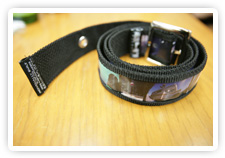 マイクはインタビューの始めに、ゴールドウィンのパートナーに渡す2本のベルトをバッグから取り出した。そのベルトはマイク自身のハンドメイドで、それは彼が何年もかけて撮り貯めた何枚もの写真が並んでいて、カメラフィルムを思わせるデザインだった。
マイクはインタビューの始めに、ゴールドウィンのパートナーに渡す2本のベルトをバッグから取り出した。そのベルトはマイク自身のハンドメイドで、それは彼が何年もかけて撮り貯めた何枚もの写真が並んでいて、カメラフィルムを思わせるデザインだった。
付属のタグには「Individually built from a 100% experience. Underground since 1991(一つ一つ100%経験から製造。1991年からアンダーグラウンドにて)」と書かれていた。
At the beginning of this interview Mike pulled two belts out of a bag to give to his working partners at Goldwin. The belts were hand made by Mike Himself. Each one looked like a filmstrip, made up of pictures that he has taken over the years. The tag said, “Individually built from a 100% experience. Underground since 1991”
![]()
流行っているからといって何かをしたことはないよ。普段は座って絵を描いてて、自分が何をしたいかをベースにストレートに表現してる。これは会社の真髄としてキープし続けてていることだよ。「ライダーのほしいもの・雪のなかで快適に過ごすためのもの」ただそれだけだね。売れるか売れないかが焦点じゃなくて自分つまりライダー達がほしいものを作るんだ。運良くゴールドウィンはやりたいことをやらせてくれる信念をもってくれているし。何が100個・1,000個・100,000個売れても関係ない。自分がほしいものを作る。誰かが100,000個売れるとしても、その中に入りたくはないね。自分が雪と共にあるときに、正しく感じられることで幸せであれることだけをするだけだよ。
高校卒業と同時にブランドを作り上げるなんて想像できるだろうか?それは決して簡単なことではない。マイクはアメリカならではの起業精神の持ち主だ。スノーボードにアート、会社立ち上げと様々なことを欲する原動力は一体なんなのか。次回この疑問を解明すべくマイク・バシッチの幼少期についてパート2で取り上げる。さらに、マイクのフィルム製作や、有名なセルフポートレートについても伝えていきたい。
![]()
Well I have never done anything because it is the hip thing, usually when I sit down and draw, it is just straight thought based on what I want to do that is what I have tried to keep as the heart of the company, just doing what a rider needs. Making things to be comfortable in the snow. I don’t think about whether things will sell or not, I make what I want to have. Luckily Goldwin has always had the faith in me to let me do what I want to do. It doesn’t matter if something sells 100 or 1000 or 100 thousand units I will just make what I want to. Somebody else can sell 100 thousand units I don’t want to be a part of that, I just want to do what feels right to me so I am happy when I am in the snow.
Wow! Can you imagine creating your own brand right out of high school? That is not an easy thing to do. Mike certainly had the American Entrepreneurial spirit! Snowboarding, art, producing his own company, what could have made him want to do all those different thing? Check back again for part two of our interview with Mike Basich, next time we will talk about his childhood and roots. We will also talk about his now famous self-portraits and more recent film projects.
Prohibited to Use or Copy All Pictures and Article
Special Thanks
NAOMI / MR. / ATSU / 3rd eYe’s DESIGN



